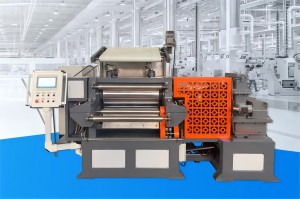
What Is a Calendering and Mixing Mill Machine and Why It Matters in Rubber Production
2025-11-04
In our previous blogs, we talked about Three-Roll and Six-Roll Stripping Machines, exploring how they shape and refine rubber sheets before further processing. But what happens next in the production line?
That’s where the Calendering and Mixing Mill Machine steps in — a true workhorse that ensures consistency, strength, and smoothness in every piece of rubber that leaves your factory floor.
Understanding the Basics: What Does a Calendering and Mixing Mill Do?
At its core, a Calendering and Mixing Mill Machine combines two vital stages of rubber processing:
-
Mixing – blending raw rubber with additives, pigments, and chemicals.
-
Calendering – pressing and shaping the rubber into thin, uniform sheets.
You can think of it like a giant pasta maker for rubber — it kneads, flattens, and refines the material until it’s ready for further production, whether for tires, belts, seals, or industrial components.
It sounds simple, but in reality, the precision required is incredible. The roller pressure, temperature, and mixing time all need perfect balance.
Why Mixing and Calendering Together Saves Time and Improves Quality
In traditional setups, mixing and calendering are done separately. However, modern Calendering and Mixing Mill Machines integrate these stages into one continuous process.
That means:
-
Less manual handling
-
Higher efficiency
-
Reduced contamination risk
-
Better control over material uniformity
In other words, it’s not just faster — it’s smarter.
This is particularly valuable for factories that already use Three-Roll or Six-Roll Stripping Machines, because the calendering system ensures a consistent feed of pre-mixed, high-quality rubber to those machines. It’s all part of a smooth, automated production flow.
The Role of Temperature and Pressure Control
Just like we mentioned in our previous blogs about stripping machines, temperature control is absolutely crucial.
A well-designed Calendering and Mixing Mill Machine features independent temperature zones and precise control systems. These help:
-
Prevent overheating or scorching of the rubber
-
Ensure consistent sheet thickness
-
Improve bonding and texture of the final product
When the pressure and temperature are in sync, the resulting rubber sheet is not only smoother but also more durable — saving time and material costs in later processing steps.
Key Components That Make a Difference
A few parts of the machine deserve special attention:
-
Rollers: Typically made from chilled cast iron for long life and smooth finish.
-
Gear System: Synchronizes roller speed and pressure for even calendering.
-
Cooling & Heating Units: Maintain optimal processing temperature.
-
Mixing Blades: Designed for uniform distribution of materials.
Every detail contributes to better rubber consistency and higher production reliability.
Daily Operation Tips: Keeping Things Simple
Now, here’s the thing — even the best machine needs good habits.
A few daily routines can go a long way:
-
Always preheat rollers before operation.
-
Avoid overloading the mixer — it reduces efficiency.
-
Clean rollers right after use to prevent buildup.
-
Regularly check the gap between rollers.
It might sound like basic stuff, but trust me, skipping these steps is one of the most common causes of production issues.
Connecting the Dots: Why It Complements Stripping Machines
If you’ve been following our previous articles, you already know how Stripping Machines are used to refine rubber sheets after calendering. The Calendering and Mixing Mill prepares those sheets in the first place — ensuring that what goes into the stripping process is already uniform and well-compounded.
That’s why these machines often work together in one continuous Rubber Production Line — from mixing, calendering, and stripping, all the way to finishing.
In fact, many clients who purchased our Three-Roll Stripping Machine later upgraded to include our Calendering and Mixing Mill, achieving better efficiency and product stability.
Conclusion: A Smart Investment for Smarter Production
The Calendering and Mixing Mill Machine is more than just a piece of industrial equipment — it’s the foundation of high-quality rubber manufacturing.
By combining mixing and calendering into one streamlined process, it reduces waste, enhances precision, and connects seamlessly with stripping systems for full-line productivity.
So, whether you’re running a new factory or upgrading an existing one, investing in a well-designed Calendering and Mixing Mill means investing in your long-term production success.


